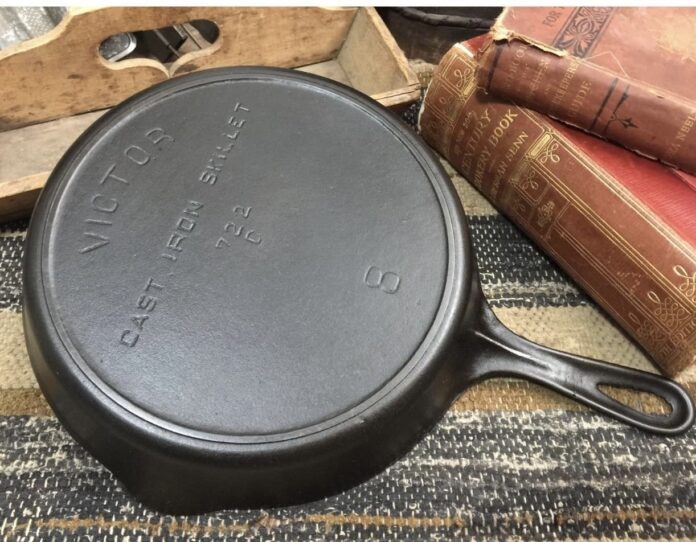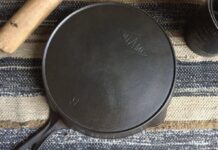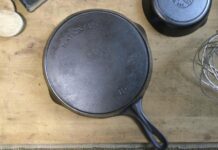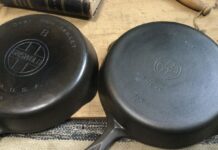Do you have a Victor cast iron skillet or waffle maker? You could be interested in learning the history of these vintage pieces and the sizes available. I will also attempt to create a possible timeline for your Victor cast iron. So you can estimate the date of manufacture.
You will also be able to identify the different markings on the ironware and become familiar with the different eras of Victor skillets made by the Griswold Manufacturing Company.
Table Of Contents
- Non-Griswold Victor ironware
- History
- Is Victor cast iron any good?
- Victor skillet sizes
- Logos and markings
- Conclusion
Learn To Identify And Date Antique Victor Cast Iron Skillets
Non-Griswold Victor Cast Iron
Victor, for some reason, is a popular name for ironware. And you may come across antique and new cast iron using Victor as the brand name. For example, Victor is a cast iron kitchen scale maker’s brand name.
A fancy-handled, odorless skillet from the late 1800s sometimes comes into the market and is often associated with Victor Stove Works.
History
The history of Victor cast-iron is 100 percent connected with Griswold Manufacturing. Griswold manufactured the cookware in the Erie Foundry alongside their main cookware line, Erie and later Griswold.
If you want to learn about the history of Griswold cast iron, click the link to learn more.
Griswold Manufacturing likely introduced the Victor line in the late 1800s to cater to the budget-conscious consumer. Undoubtedly, many people were more penny-wise than they are today.
For others, there was no choice but to choose lower-cost options.
Other foundries also had a low-cost range of cookware to capitalize on this market.
- Wagner Manufacturing
- Wapak
- Favorite Stove and Range
Is Victor Cast Iron Any Good?
There is a misconception that economy lines or store brands are of poorer quality. But this is far from the truth. And from my experience, Victor cast iron is just as smooth as my regular Griswold pans. And I have seen many examples of Victor castings with incredibly smooth cooking surfaces.
So, if Griswold manufactured these pans to the same quality, how did they separate the budget-friendly Victor cookware from the more expensive Erie and Griswold cast iron? It looks like Griswold manufactured the budget-friendly line of cast-iron cookware with a slightly smaller diameter and lower sidewalls.
Victor Cast Iron Skillet Sizes
The Most Common Sizes Are 7, 8, and 9.
Another difference between Griswold’s standard line and the Victor line is the number of sizes. From around 1909, Griswold was producing skillets between 2 and 14.
However, Griswold limited the sizes of the Victor line. And you will likely find the standard sizes of 7, 8, and 9 on Victor skillets. These sizes were the most common and practical for household needs.
The Rare Sizes Are 5 And 6.
On the fully marked skillets, Griswold introduced sizes 5 and 6. And these are rare sizes in the Victor cast iron line.
Why Did Griswold Only Make Victor Skillets In Limited Sizes?
Limiting the sizes of the pans had two purposes. Griswold most likely wanted another differential between the Victor and regular lines.
And second, Victor cast iron consumers were most likely not frivolous with their funds. And many households probably had a simple wood-burning stove. So large and small cookware was probably impractical and unfeasible for many buyers.
| Skillet Style | Markings on Pan | Sizes |
|---|---|---|
| Victor | Victor + Three Digit Number | 7, 8, 9 |
| Victor Cast Iron Skillet | Victor + Cast Iron Skillet + Three Digit Number | 7, 8, 9 |
| Fully Marked Victor Skillet | As above + The Griswold Manufacturing Co + Erie PA, U.S.A. | 5, 6, 7, 8, 9 |
How Old Is My Victor Cast Iron Skillet?
There are slight variations, such as logo placement on skillets. However, collectors typically recognize three eras of the skillet, and they are:
- Early Victor Skillets
- Victor (with Cast Iron Skillet Wording)
- Fully Marked Victor (with Griswold with E.P.U. marking)
We can also get an approximation of the age by looking at the placement of the heat ring. By cross-examining Victor’s skillets with Erie’s and Griswold’s skillets,
| Skillet Style | Heat Ring | Approximate Age |
|---|---|---|
| Early Victor | Outer Heat Ring | Circa 1895 -1905 |
| Early Victor | Insert Heat Ring | Circa 1905-1909 |
| Victor Skillet Cast Iron Skillet | Insert Heat Ring | Circa 1909-1920 |
| Fully Marked Victor | Insert Heat Ring | Circa 1920-1935 |
Victor Skillets
Early skillets take on the characteristics of early Erie skillets. They have an outer or insert heat ring, and the R in VICTOR resembles the flick on some ERIE skillets.
Because of these identifiers, we can loosely assume the age of the skillet to be circa the 1890s to early 1900s for skillets with a three-digit numbering system in the center of the pan.
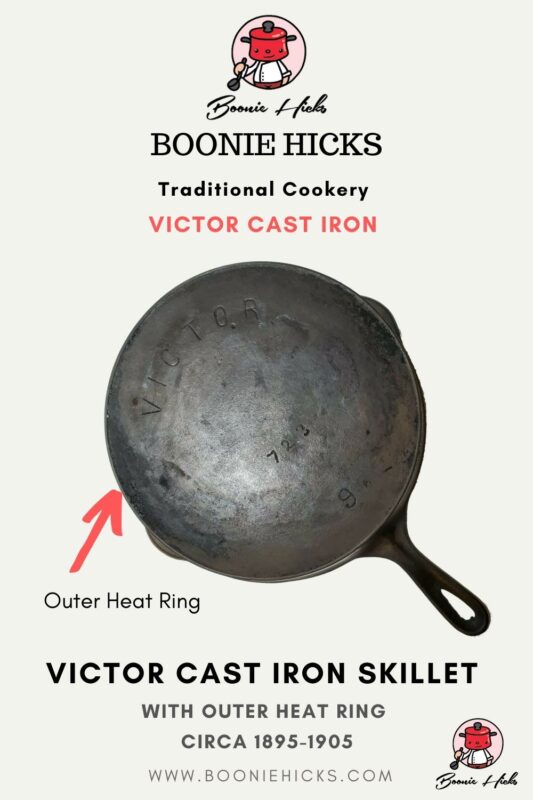
Possible Early Series Victor Skillets
There are potentially skillets with an outer heat ring without the three-digit numbering system. These skillets could be dated from the 1880s if confirmed, as enthusiasts would reference the period’s first series of Erie skillets.
However, I have not seen a skillet without the three digits. Some have sulfur pitting, so I can not confirm this era of skillets.
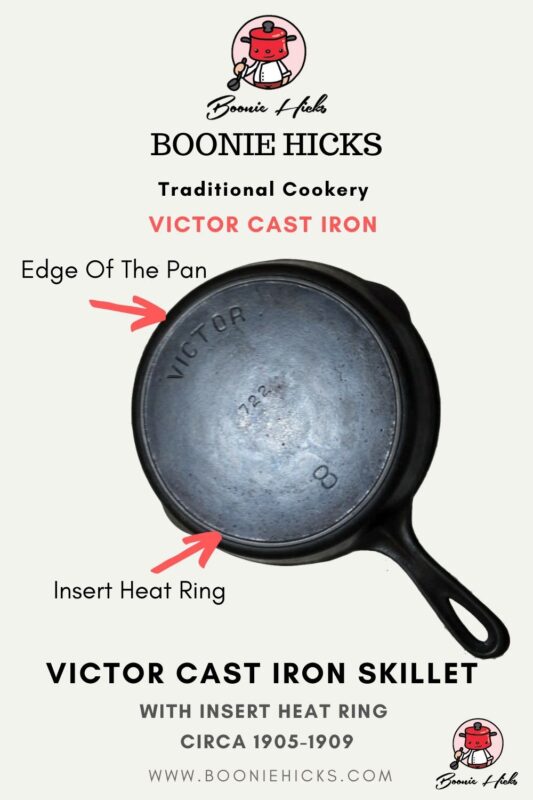
Cast Iron Skillet Wording
This logo adds some embellishments to the ironware. The word cast iron skillet is present under the Victor marking.
Vintage cast iron enthusiasts can also determine this skillet comes after the previous logo because of the presence of an insert heat ring. On Erie skillets, insert heat rings were present from the third series. So, we can assume the semi-markers are from circa 1904 or 1905.
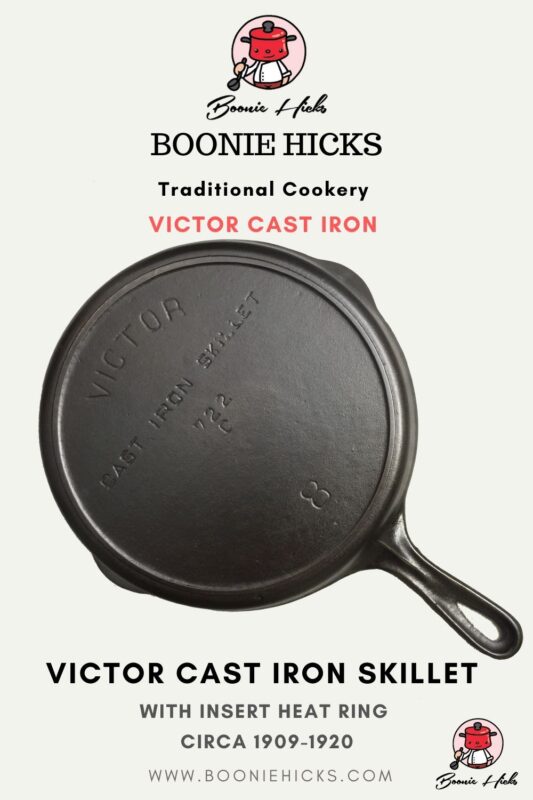
The Fully Marked Victor Logo
The fully marked logo is a favorite for many Victor Cast iron collectors. Skillets with this marking also have a Griswold and E.P.U. branding. Skillets with this marking are likely to be circa the 1920s. Size number 6 entered the market around the mid-1920s, and size number 5 in the early 1930s.
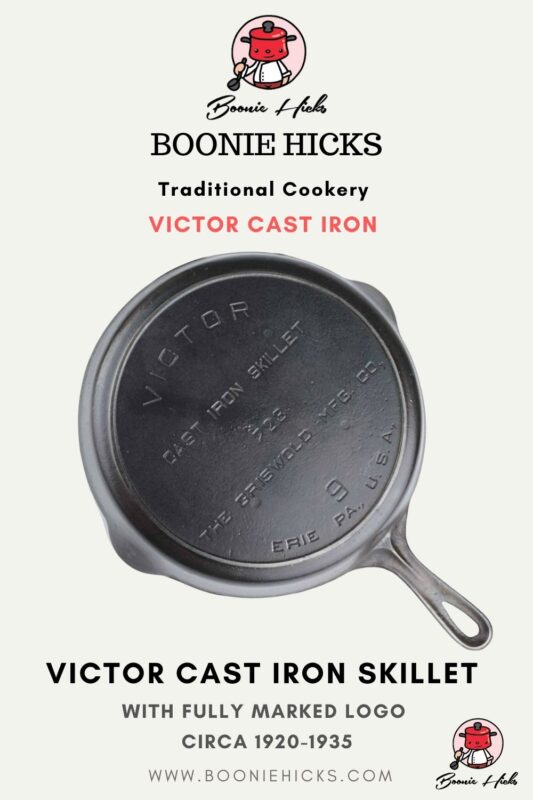
Victor Cast Iron By Griswold Manufacturing
Victor cast iron skillets are attractive pieces of vintage cast iron. And like other Griswold-made ironware, the cooking surface is very smooth.
Luckily for us, skillets often sell for less than Griswold-marked cookware. So look around, and you may pick up a bargain piece of ironware that will cook and higher-priced Griswold cast iron.
I trust you can now correctly identify the logo on your skillet. And get an estimate on the manufacturing date. The dates are an approximation and by no means concrete. But by comparing Erie skillets and Griswold, we can get a fair idea of when Griswold made the ironware.
More importantly, I hope you have fun using your Victor. After all, they are fantastic cookware made by arguably one of the best foundries to manufacture cast iron.


